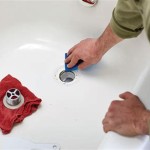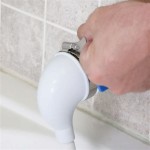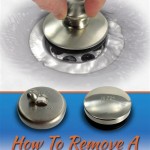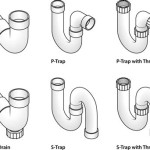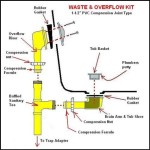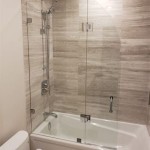How To Fix a Bathtub Drain Stopper Stuck in Closed Position
A clogged or malfunctioning bathtub drain stopper is a common household plumbing issue. When the stopper becomes lodged in the closed position, it prevents water from draining, rendering the bathtub unusable. This situation can arise from a buildup of hair, soap scum, mineral deposits, or mechanical failure within the stopper mechanism itself. Addressing a stuck bathtub drain stopper promptly can prevent further complications such as overflowing tubs, potential water damage, and the unpleasant task of repeatedly bailing out standing water.
Diagnosing the reason for the stuck stopper is the initial step in resolving the problem. Examining the type of stopper and associated hardware is crucial for determining the appropriate course of action. Various stopper types exist, including pop-up stoppers, lift-and-turn stoppers, toe-touch stoppers, and trip-lever stoppers, each with unique mechanisms and potential failure points. A basic understanding of these mechanisms is necessary to effectively troubleshoot and repair the issue.
This article provides a detailed guide to diagnosing and resolving a bathtub drain stopper that is stuck in the closed position. It will cover common causes, provide step-by-step instructions for various stopper types, and offer preventative measures to avoid future occurrences. By following these guidelines, individuals can often resolve the issue themselves, avoiding the need for a professional plumber and saving time and money.
Identifying the Type of Bathtub Drain Stopper
Before attempting any repairs, accurately identifying the type of drain stopper installed in the bathtub is paramount. Each type operates differently and requires a specific approach for removal and troubleshooting. The most common types include:
* Pop-Up Stoppers: These stoppers feature a small, usually round, cap that sits flush with the drain opening. Pressing down on the cap causes it to pop up and close the drain; pressing it again releases it to allow drainage. The mechanism is typically linked to a rocker arm beneath the drain. * Lift-and-Turn Stoppers: These stoppers have a knob or lever on top that can be lifted and turned to open or close the drain. An internal linkage rotates a disc or plug to control the water flow. * Toe-Touch Stoppers: Similar in appearance to pop-up stoppers, toe-touch stoppers are operated by pressing down on the stopper with a toe or foot. Typically, one press closes the drain, and another press opens it. * Trip-Lever Stoppers: These stoppers are controlled by a lever located on the overflow plate, usually near the top of the bathtub. Pulling or pushing the lever raises or lowers a plunger inside the drainpipe to control the water flow.Once the stopper type is identified, a targeted approach can be taken to diagnose the problem and implement the appropriate solution. In many instances, a simple cleaning or adjustment can resolve the issue.
Troubleshooting Common Causes of a Stuck Bathtub Drain Stopper
Several factors can contribute to a bathtub drain stopper becoming stuck in the closed position. The most frequent causes include:
* Hair and Debris Accumulation: Hair, soap scum, and other debris can become entangled around the stopper and the internal mechanism, hindering its movement. This is especially common with pop-up and toe-touch stoppers, where the linkage is located directly within the drainpipe. * Mineral Deposits: Hard water can lead to mineral deposits accumulating on the stopper and surrounding components, causing them to seize up or become difficult to move. This is particularly problematic in areas with high mineral content in the water supply. * Corrosion and Rust: Over time, metal components within the stopper mechanism can corrode or rust, leading to reduced functionality and eventual failure. This is more likely in older bathtubs and those with metal stoppers. * Mechanical Failure: The internal linkages and components of the stopper mechanism can break, bend, or become dislodged, preventing the stopper from opening or closing properly. This is more common in complex stopper systems like trip-lever mechanisms. * Improper Installation or Adjustment: If the stopper was not installed correctly or if the linkage is not properly adjusted, it may not function smoothly, leading to it becoming stuck in the closed position. This is often seen immediately after a new stopper installation.By systematically evaluating these potential causes, the source of the problem can often be identified. Once the cause is known, the appropriate repair or cleaning method can be applied.
Step-by-Step Solutions for Different Stopper Types
The process for fixing a stuck bathtub drain stopper varies depending on the type of stopper in use. The following sections provide detailed instructions for each type, addressing common problems and offering practical solutions.
Pop-Up Stoppers
Pop-up stoppers are prone to hair and debris buildup. The following steps outline how to resolve a stuck pop-up stopper:
1. Remove the Stopper: Most pop-up stoppers can be removed by simply pulling them straight up. Some may require a slight twisting motion. If the stopper is very tight, use pliers wrapped in a cloth to gently grip and pull it out. 2. Clean the Stopper and Drain Opening: Once removed, thoroughly clean the stopper, removing any hair, soap scum, or debris. Use a small brush or a toothpick to reach into crevices. Clean the drain opening as well, using a bent wire or a specialized drain cleaning tool to remove any obstructions. 3. Inspect the Rocker Arm: Look inside the drain opening to locate the rocker arm (a horizontal bar that connects to the stopper). Check for any accumulation of debris or mineral deposits. Clean the rocker arm and surrounding area. 4. Reassemble and Test: Reinsert the stopper and test its functionality. If the stopper is still sticking, the rocker arm may need adjustment. Some rocker arms have adjustment screws; consult the manufacturer's instructions for details. If no adjustment is possible the rocker arm and stopper assembly may need replacement.Lift-and-Turn Stoppers
Lift-and-turn stoppers often become stuck due to corrosion or debris accumulation around the internal linkage. The following steps outline how to address this issue:
1. Remove the Knob: Typically, the knob can be unscrewed or pried off (consult the manufacturer’s instructions). Some knobs may have a set screw that needs to be loosened first. 2. Unscrew the Stopper Mechanism: Once the knob is removed, the stopper mechanism can usually be unscrewed from the drain opening. 3. Clean and Inspect: Disassemble the stopper mechanism, cleaning all parts thoroughly. Pay close attention to the threads and any moving parts. Look for signs of corrosion or damage. Use a descaling solution to remove mineral deposits. 4. Lubricate and Reassemble: Apply a silicone-based lubricant to the threads and moving parts before reassembling the stopper. This will help prevent future sticking. 5. Test and Adjust: After reassembly, test the stopper to ensure it opens and closes smoothly. If necessary, adjust the length of the screw or setting of the mechanism for proper engagement with the drain opening.Toe-Touch Stoppers
Toe-touch stoppers are similar to pop-up stoppers and are often affected by hair and debris. Repairing a stuck toe-touch stopper generally follows similar steps to the pop-up type:
1. Remove The Stopper: Many toe-touch stoppers unscrew; twist counterclockwise to remove the stopper assembly. Some may require a small amount of prying. 2. Clean the Stopper Assembly: Disassemble the stopper assembly and thoroughly clean each part. Hair and soap scum are common culprits. Clean the drain opening. 3. Check and Clean the Internal Mechanism: Examine the internal mechanism for blockage or damage. Use a small brush or wire to clear any obstructions. 4. Reassemble and Test: Reassemble the stopper, ensuring all parts are properly aligned. Test the stopper by pressing down on it to open and close the drain. If it still sticks, further disassembly and cleaning may be required.Trip-Lever Stoppers
Trip-lever stoppers are more complex than other types and often require accessing the overflow drain. The procedure can be more labor intensive, but the results can be rewarding.
1. Remove the Overflow Plate: Unscrew the overflow plate located near the top of the bathtub. 2. Pull Out the Linkage: Carefully pull out the linkage connected to the trip lever. This linkage usually consists of a rod and a plunger. 3. Clean the Plunger: Clean the plunger thoroughly, removing any hair, soap scum, or debris. Check for wear or damage. A worn plunger will not seal properly. 4. Inspect the Linkage: Examine the linkage for bends, breaks, or corrosion. If necessary, replace the linkage. 5. Clean the Drainpipe: Use a drain snake or a specialized drain cleaning tool to remove any obstructions from the drainpipe. 6. Reassemble and Adjust: Reinsert the linkage and overflow plate ensuring correct alignment. Test the trip lever. Adjustment may be needed to get proper sealing on the drain opening. This typically involves adjusting the length of the rod that connects the trip lever to the plunger.Preventative Measures for Avoiding Future Problems
Preventing a bathtub drain stopper from becoming stuck in the first place is often easier than fixing it after the fact. Implementing several preventative measures can significantly reduce the likelihood of future issues.
* Install a Drain Hair Catcher: A simple and effective way to prevent hair from clogging the drain is to install a hair catcher. These inexpensive devices fit over the drain opening and trap hair and other debris before they can enter the drainpipe. Cleaning the hair catcher regularly will prevent buildup and maintain proper drainage. * Regular Cleaning: Periodically cleaning the drain and stopper can prevent the accumulation of soap scum, mineral deposits, and other debris. Pouring boiling water down the drain once a week can help flush out loose debris. Using a drain cleaner specifically designed for bathtub drains can also help dissolve buildup. Follow the manufacturer’s instructions carefully when using drain cleaners. * Avoid Harsh Chemicals: While drain cleaners can be effective, using harsh chemicals can damage the pipes and the stopper mechanism. Opt for enzymatic cleaners, which are gentler on the plumbing system and more environmentally friendly. * Maintain Adequate Water Flow: Ensuring adequate water flow while bathing can help prevent debris from settling in the drainpipe. A strong water flow will help flush out loose particles and prevent them from accumulating. * Regular Inspection and Maintenance: Periodically inspecting the stopper mechanism and lubricating moving parts can help prevent corrosion, seizing, and other mechanical issues. Use a silicone-based lubricant specifically designed for plumbing fixtures. * Water Softener Installation: In areas with hard water, installing a water softener can help reduce the accumulation of mineral deposits on the stopper and other plumbing fixtures. A water softener removes minerals from the water supply, preventing them from forming scale and buildup.By implementing these preventative measures, individuals can significantly reduce the likelihood of encountering a stuck bathtub drain stopper, ensuring a functional and hassle-free bathing experience.

Bathtub How Can I Remove A Stuck Bath Stopper Assembly Home Improvement Stack Exchange

Bathroom Repair How To A Pop Up Tub Drain Stopper

How To Fix A Stuck Bathtub Drain

How To Fix A Bathtub Or Sink Pop Up Stopper

How To Remove A Bathtub Drain Stopper Step By Guide

How To Remove A Bathtub Drain Stopper

How To Fix A Stuck Sink Stopper Fast Easy Diy Solutions

How To Remove A Bathtub Drain Stopper

How To Fix A Stuck Sink Stopper Fast Easy Diy Solutions

How To Fix Sink Stopper Stuck Open And Close Positions
Related Posts

